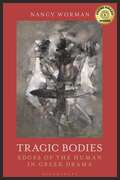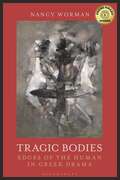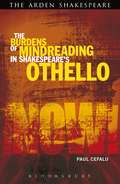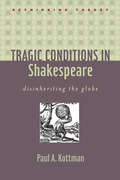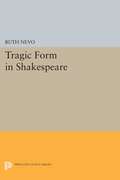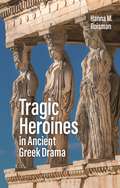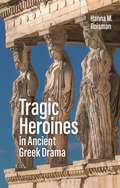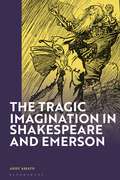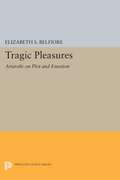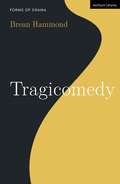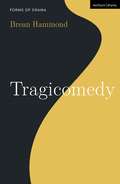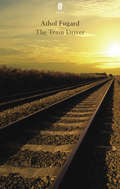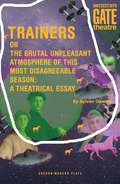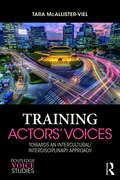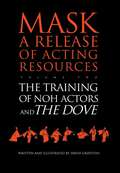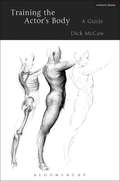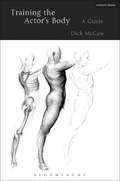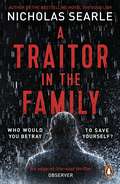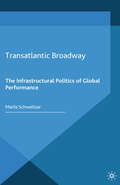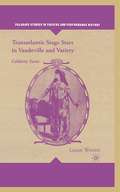- Table View
- List View
Tragic Bodies: Edges of the Human in Greek Drama
by Nancy WormanThis book argues for a new way of reading tragedy that attends to how bodies in the ancient plays pivot between subject and object, person and thing, living and dead, and so serve as vehicles for confronting the edges of the human. At the same time, it explores the ways in which Greek tragedy pulls up close to human bodies, examining their physical edges, their surfaces and parts, their coverings or nakedness, and their postures and orientations. Drawing on and advancing the latest interplays of posthumanism and materialism in relation to classical literature, Nancy Worman shows how this tragic enactment may seem to emphasize the human body, but in effect does something quite different. Greek drama instead often treats the body as a thing that has the status and implications associated with other objects, such as a cloak, an urn, or a toy for a dog.Tragic Bodies urges attention to key scenes in Greek tragedy that foreground bodily identifiers as semiotic materializing. This occurs when signs with weighty symbolic resonance distil out on the dramatic stage as concrete sites for contention and conflation orchestrated through proximity, contact, and sensory dynamics. Reading the dramatic script in this way pursues the felt knowledge at the body's edges that tragic representation affords, a consideration attuned to how bodies register at tragedy's unique intersections – where directive and figurative language combine to highlight visual, tactile, and aural details.
Tragic Bodies: Edges of the Human in Greek Drama
by Nancy WormanThis book argues for a new way of reading tragedy that attends to how bodies in the ancient plays pivot between subject and object, person and thing, living and dead, and so serve as vehicles for confronting the edges of the human. At the same time, it explores the ways in which Greek tragedy pulls up close to human bodies, examining their physical edges, their surfaces and parts, their coverings or nakedness, and their postures and orientations. Drawing on and advancing the latest interplays of posthumanism and materialism in relation to classical literature, Nancy Worman shows how this tragic enactment may seem to emphasize the human body, but in effect does something quite different. Greek drama instead often treats the body as a thing that has the status and implications associated with other objects, such as a cloak, an urn, or a toy for a dog.Tragic Bodies urges attention to key scenes in Greek tragedy that foreground bodily identifiers as semiotic materializing. This occurs when signs with weighty symbolic resonance distil out on the dramatic stage as concrete sites for contention and conflation orchestrated through proximity, contact, and sensory dynamics. Reading the dramatic script in this way pursues the felt knowledge at the body's edges that tragic representation affords, a consideration attuned to how bodies register at tragedy's unique intersections – where directive and figurative language combine to highlight visual, tactile, and aural details.
Tragic Cognition in Shakespeare's Othello: Beyond the Neural Sublime (Shakespeare Now!)
by Paul CefaluPaul Cefalu argues that Shakespearean characters raise timely questions about the relationship between cognition and consciousness and often defy our assumptions about "normal†? cognition. The book will appeal to scholars and students interested in both the virtuesand limitations of cognitive literary criticism.
Tragic Cognition in Shakespeare's Othello: Beyond the Neural Sublime (Shakespeare Now!)
by Paul CefaluPaul Cefalu argues that Shakespearean characters raise timely questions about the relationship between cognition and consciousness and often defy our assumptions about “normal” cognition. The book will appeal to scholars and students interested in both the virtuesand limitations of cognitive literary criticism.
Tragic Conditions in Shakespeare: Disinheriting the Globe (Rethinking Theory)
by Paul A. KottmanPaul A. Kottman offers a new and compelling understanding of tragedy as seen in four of Shakespeare’s mature plays—As You Like It, Hamlet, King Lear, and The Tempest. The author pushes beyond traditional ways of thinking about tragedy, framing his readings with simple questions that have been missing from scholarship of the past generation: Are we still moved by Shakespeare, and why? Kottman throws into question the inheritability of human relationships by showing how the bonds upon which we depend for meaning and worth can be dissolved. According to Kottman, the lives of Shakespeare's protagonists are conditioned by social bonds—kinship ties, civic relations, economic dependencies, political allegiances—that unravel irreparably. This breakdown means they can neither inherit nor bequeath a livable or desirable form of sociality. Orlando and Rosalind inherit nothing "but growth itself" before becoming refugees in the Forest of Arden; Hamlet is disinherited not only by Claudius’s election but by the sheer vacuity of the activities that remain open to him; Lear’s disinheritance of Cordelia bequeaths a series of events that finally leave the social sphere itself forsaken of heirs and forbearers alike. Firmly rooted in the philosophical tradition of reading Shakespeare, this bold work is the first sustained interpretation of Shakespearean tragedy since Stanley Cavell’s work on skepticism and A. C. Bradley’s century-old Shakespearean Tragedy.
Tragic Form in Shakespeare
by Ruth NevoA "symbolist" approach has dominated Shakespearean criticism for many years, but Ruth Nevo believes that the emphasis on static and pictorial aspects has obscured the essentially dynamic nature of dramatic expression and this study of the development of Shakespeare's tragic form is offered to correct the imbalance.From detailed analyses of each of Shakespeare's ten tragedies emerges a characteristic structure—a five-phased movement of discovery—that articulates and orders the traditional components of tragedy. This sequence is one of predicament, psychomachia, peripeteia, perspectives of irony and pathos, and catastrophe. It is a continuous, accumulative, and consummatory one, rather than a simple up-down movement or even a more complex thesis-antithesis-synthesis. Inheriting a five-act model and its developed rationale, Shakespeare used it to express an ever richer and more complex tragic experience. As the protagonist's life unfolds before us, the development of his tragic recognition is coextensive with the whole of the action.Originally published in 1972.The Princeton Legacy Library uses the latest print-on-demand technology to again make available previously out-of-print books from the distinguished backlist of Princeton University Press. These editions preserve the original texts of these important books while presenting them in durable paperback and hardcover editions. The goal of the Princeton Legacy Library is to vastly increase access to the rich scholarly heritage found in the thousands of books published by Princeton University Press since its founding in 1905.
Tragic Heroines in Ancient Greek Drama
by Hanna M. RoismanThe heroines of Greek tragedy presented in the plays by Aeschylus, Sophocles and Euripides have long captivated audiences and critics. In this volume each of the eleven chapters discusses one of the heroines: Clytemnestra, Hecuba, Medea, Iphigenia, Alcestis, Antigone Electra, Deianeira, Phaedra, Creusa and Helen. The book focuses on characterisation and the motivations of the women, as well as on those of the male playwrights, and offers multiple viewpoints and critiques that enable readers to understand the context of each play and form their own views. Four core themes bridge the depictions of the heroines: the socio-political dynamic of ancient Greek expectations of women and their roles in society, the conflict of masculinity versus femininity, the alternation of defiance and submission, and the interplay between deceit and rhetoric. Each chapter offers clear descriptions of plot and mythical background, and builds on the text of the plays to enable reflections on language and performance. All technical terms are explained and key topics or references are pulled out into box features that provide further background information. Discussion points at the ends of chapters enable readers to explore various topics more deeply.
Tragic Heroines in Ancient Greek Drama
by Hanna M. RoismanThe heroines of Greek tragedy presented in the plays by Aeschylus, Sophocles and Euripides have long captivated audiences and critics. In this volume each of the eleven chapters discusses one of the heroines: Clytemnestra, Hecuba, Medea, Iphigenia, Alcestis, Antigone Electra, Deianeira, Phaedra, Creusa and Helen. The book focuses on characterisation and the motivations of the women, as well as on those of the male playwrights, and offers multiple viewpoints and critiques that enable readers to understand the context of each play and form their own views. Four core themes bridge the depictions of the heroines: the socio-political dynamic of ancient Greek expectations of women and their roles in society, the conflict of masculinity versus femininity, the alternation of defiance and submission, and the interplay between deceit and rhetoric. Each chapter offers clear descriptions of plot and mythical background, and builds on the text of the plays to enable reflections on language and performance. All technical terms are explained and key topics or references are pulled out into box features that provide further background information. Discussion points at the ends of chapters enable readers to explore various topics more deeply.
The Tragic Imagination in Shakespeare and Emerson
by Andy AmatoWhat is the “tragic imagination”? And what role does it play in the works of William Shakespeare and Ralph Waldo Emerson? Explaining the tragic imagination as a creative faculty employed to answer the perennial Riddle of the Sphinx – a theory of the world that advances human freedom and dignity in the face of historical injustice, cruelty and violence – Andy Amato seeks to recover and rehabilitate this concept by revealing its significance to both key works of philosophy and literature and our contemporary world. This book begins with a close and careful reading of Emerson's first major work, Nature, in conversation with nineteenth and 20thcentury continental philosophy, critical theory and post-structuralism. Uncovering neglected elements of Emerson's philosophy, beyond his reputation as the philosopher of 'cheer', this book explores how Emersonian transcendentalism affirms rather than denies the tragic sense of life – “tragic idealism” – and makes a substantial contribution to philosophy's perpetual endeavour to solve the Riddle. In the second part of the book, Amato then employs Emerson's theoretical lens to interpret Shakespeare's tragedy, King Lear. In doing so, he innovatively reframes the central themes of suffering, vision, nature, nothing, foolishness and silence toward achieving liberation.By pairing these two giants of literature and philosophy, The Tragic Imagination in Shakespeare and Emerson not only offers fresh interpretations of Nature and King Lear, but also makes the case for the renewed deployment of tragic imagination, in creative redress, to our current social-political situation.
The Tragic Imagination in Shakespeare and Emerson
by Andy AmatoWhat is the “tragic imagination”? And what role does it play in the works of William Shakespeare and Ralph Waldo Emerson? Explaining the tragic imagination as a creative faculty employed to answer the perennial Riddle of the Sphinx – a theory of the world that advances human freedom and dignity in the face of historical injustice, cruelty and violence – Andy Amato seeks to recover and rehabilitate this concept by revealing its significance to both key works of philosophy and literature and our contemporary world. This book begins with a close and careful reading of Emerson's first major work, Nature, in conversation with nineteenth and 20thcentury continental philosophy, critical theory and post-structuralism. Uncovering neglected elements of Emerson's philosophy, beyond his reputation as the philosopher of 'cheer', this book explores how Emersonian transcendentalism affirms rather than denies the tragic sense of life – “tragic idealism” – and makes a substantial contribution to philosophy's perpetual endeavour to solve the Riddle. In the second part of the book, Amato then employs Emerson's theoretical lens to interpret Shakespeare's tragedy, King Lear. In doing so, he innovatively reframes the central themes of suffering, vision, nature, nothing, foolishness and silence toward achieving liberation.By pairing these two giants of literature and philosophy, The Tragic Imagination in Shakespeare and Emerson not only offers fresh interpretations of Nature and King Lear, but also makes the case for the renewed deployment of tragic imagination, in creative redress, to our current social-political situation.
Tragic Pleasures: Aristotle on Plot and Emotion
by Elizabeth S. BelfioreElizabeth Belfiore offers a striking new interpretation of Aristotle's Poetics by situating the work within the Aristotelian corpus and in the context of Greek culture in general. In Aristotle's Rhetoric, the Politics, and the ethical, psychological, logical, physical, and biological works, Belfiore finds extremely important but largely neglected sources for understanding the elliptical statements in the Poetics. The author argues that these Aristotelian texts, and those of other ancient writers, call into question the traditional view that katharsis in the Poetics is a homeopathic process--one in which pity and fear affect emotions like themselves. She maintains, instead, that Aristotle considered katharsis to be an allopathic process in which pity and fear purge the soul of shameless, antisocial, and aggressive emotions. While exploring katharsis, Tragic Pleasures analyzes the closely related question of how the Poetics treats the issue of plot structure. In fact, Belfiore's wide-ranging work eventually discusses every central concept in the Poetics, including imitation, pity and fear, necessity and probability, character, and kinship relations.Originally published in 1992.The Princeton Legacy Library uses the latest print-on-demand technology to again make available previously out-of-print books from the distinguished backlist of Princeton University Press. These editions preserve the original texts of these important books while presenting them in durable paperback and hardcover editions. The goal of the Princeton Legacy Library is to vastly increase access to the rich scholarly heritage found in the thousands of books published by Princeton University Press since its founding in 1905.
Tragicomedy (Forms of Drama)
by Brean HammondThis succinct authoritative book offers readers an overview of the origins, characteristics, and changing status of tragicomedy from the 17th century to the present. It explores the work of some of the key English and Irish playwrights associated with the form, the influence of Italian and Spanish theorist-playwrights and the importance of translations of Pierre Corneille's Le Cid. At the turn of the 17th century, English dramatists such as John Marston, John Fletcher, and William Shakespeare began experimenting with plays that mixed elements of tragedy and comedy, producing a blended mode that they themselves called 'tragicomedy'. This book begins by examining the sources of their inspiration and the theatrical achievement that they hoped to gain by confronting an audience with plays that defied the plot and character expectations of 'pure' comedy and tragedy. It goes on to show how, reacting to French models, John Dryden, Shakespeare 'improvers' and other English playwrights developed the form while sowing the seeds of its own vulnerability to parody and obsolescence in the eighteenth century. Discussing nineteenth-century melodrama as in some respects a resurrection of tragicomedy, the final chapter concentrates on plays by Ibsen, Chekhov, and Beckett as examples of the form being revived to create theatrical modes that more adequately represent the perceived complexity of experience.
Tragicomedy (Forms of Drama)
by Brean HammondThis succinct authoritative book offers readers an overview of the origins, characteristics, and changing status of tragicomedy from the 17th century to the present. It explores the work of some of the key English and Irish playwrights associated with the form, the influence of Italian and Spanish theorist-playwrights and the importance of translations of Pierre Corneille's Le Cid. At the turn of the 17th century, English dramatists such as John Marston, John Fletcher, and William Shakespeare began experimenting with plays that mixed elements of tragedy and comedy, producing a blended mode that they themselves called 'tragicomedy'. This book begins by examining the sources of their inspiration and the theatrical achievement that they hoped to gain by confronting an audience with plays that defied the plot and character expectations of 'pure' comedy and tragedy. It goes on to show how, reacting to French models, John Dryden, Shakespeare 'improvers' and other English playwrights developed the form while sowing the seeds of its own vulnerability to parody and obsolescence in the eighteenth century. Discussing nineteenth-century melodrama as in some respects a resurrection of tragicomedy, the final chapter concentrates on plays by Ibsen, Chekhov, and Beckett as examples of the form being revived to create theatrical modes that more adequately represent the perceived complexity of experience.
The Train Driver
by Athol FugardIn December 2000, Pumla Lolwana pulled her three children close to her body and stepped in front of a train on the railway tracks between Philippi and Nyanga on the Cape Flats, South Africa.This true story demanded Athol Fugard's attention and compelled him to write The Train Driver; a beautiful and haunting play of redemptive power. The Train Driver received its UK premiere at Hampstead Theatre, London, in November 2010.'Brave, confrontational and tender . . . Essential theatre viewing.' Sunday Times, South Africa
Trainers: Or the Brutal Unpleasant Atmosphere of this Most Disagreeable Season: a Theatrical Essay (Oberon Modern Plays)
by Sylvan OswaldThe only rule is to break the rules. In a parallel present, two queer radicals meet in the fallout of The Second American Civil War. If love is the most radical act, can their desire survive the revolution? Based on Montaigne’s intellectual love affair with political thinker Étienne de La Boétie, Sylvan Oswald’s brand-new play Trainers is a visionary story exploring the different ways we can connect as lovers, activists, and humans.
Training Actors' Voices: Towards an Intercultural/Interdisciplinary Approach (Routledge Voice Studies)
by Tara McAllister-VielContemporary actor training in the US and UK has become increasingly multicultural and multilinguistic. Border-crossing, cross-cultural exchange in contemporary theatre practices, and the rise of the intercultural actor has meant that actor training today has been shaped by multiple modes of training and differing worldviews. How might mainstream Anglo-American voice training for actors address the needs of students who bring multiple worldviews into the training studio? When several vocal training traditions are learned simultaneously, how does this shift the way actors think, talk, and perform? How does this change the way actors understand what a voice is? What it can/should do? How it can/should do it? Using adaptations of a traditional Korean vocal art, p’ansori, with adaptations of the "natural" or "free" voice approach, Tara McAllister-Viel offers an alternative approach to training actors’ voices by (re)considering the materials of training: breath, sound, "presence," and text. This work contributes to ongoing discussions about the future of voice pedagogy in theatre, for those practitioners and scholars interested in performance studies, ethnomusicology, voice studies, and intercultural theories and practices.
Training Actors' Voices: Towards an Intercultural/Interdisciplinary Approach (Routledge Voice Studies)
by Tara McAllister-VielContemporary actor training in the US and UK has become increasingly multicultural and multilinguistic. Border-crossing, cross-cultural exchange in contemporary theatre practices, and the rise of the intercultural actor has meant that actor training today has been shaped by multiple modes of training and differing worldviews. How might mainstream Anglo-American voice training for actors address the needs of students who bring multiple worldviews into the training studio? When several vocal training traditions are learned simultaneously, how does this shift the way actors think, talk, and perform? How does this change the way actors understand what a voice is? What it can/should do? How it can/should do it? Using adaptations of a traditional Korean vocal art, p’ansori, with adaptations of the "natural" or "free" voice approach, Tara McAllister-Viel offers an alternative approach to training actors’ voices by (re)considering the materials of training: breath, sound, "presence," and text. This work contributes to ongoing discussions about the future of voice pedagogy in theatre, for those practitioners and scholars interested in performance studies, ethnomusicology, voice studies, and intercultural theories and practices.
The Training of Noh Actors and The Dove (Mask - A Release Of Acting Resources Ser. #Vol. 2)
by David GriffithsFirst Published in 1998. Routledge is an imprint of Taylor & Francis, an informa company.
The Training of Noh Actors and The Dove
by David GriffithsFirst Published in 1998. Routledge is an imprint of Taylor & Francis, an informa company.
Training the Actor's Body: A Guide
by Dick McCawA practical guide to the principles of teaching and learning movement, this book instructs the actor on how to train the body to become a medium of expression. Starting with a break-down of the principles of actor training through exercises and theatre games, Dick McCaw teaches the actor about their own body and its possibilities including: the different ways it can move, the space it occupies and finally its rhythm, timing and pacing. With 64 exercises supported by diagrams and online video, Dick McCaw draws on his 20 years of teaching experience to coach the reader in the dynamics of movement education to achieve a responsive and articulate body.
Training the Actor's Body: A Guide
by Dick McCawA practical guide to the principles of teaching and learning movement, this book instructs the actor on how to train the body to become a medium of expression. Starting with a break-down of the principles of actor training through exercises and theatre games, Dick McCaw teaches the actor about their own body and its possibilities including: the different ways it can move, the space it occupies and finally its rhythm, timing and pacing. With 64 exercises supported by diagrams and online video, Dick McCaw draws on his 20 years of teaching experience to coach the reader in the dynamics of movement education to achieve a responsive and articulate body.
A Traitor in the Family
by Nicholas SearleFROM THE BESTSELLING AUTHOR OF THE GOOD LIAR, SOON TO BE A MAJOR FILM 'Unbearably tense' Daily Telegraph 'While her husband prepared to murder a young man he had never met, Bridget O'Neill completed her packing for Christmas with her in-laws.'Francis O'Neill is a terrorist, trained to kill for his cause. Bridget is his wife, expected to be loyal and stand by her husband. She has learned not to hope for much more, until the day she glimpses, for the first time, the chance of a new life. A life without violence, without secrets, and without knocks on the door in the dead of night. A life without her husband.But what if freedom for Bridget means grave danger for Francis? In A Traitor in the Family, bestselling author, Nicholas Searle, tells a story of shocking, intimate betrayal. Can a treacherous act of the most personal kind ever be, in this darkly violent world, an act of mercy?'It reminded me strongly of John le Carre ... this is high praise' Daily Mail "The Good Liar was excellent ... this is even better' Sunday Express
Transatlantic Broadway: The Infrastructural Politics of Global Performance (Transnational Theatre Histories)
by M. SchweitzerTransatlantic Broadway traces the infrastructural networks and technological advances that supported the globalization of popular entertainment in the pre-World War I period, with a specific focus on the production and performance of Broadway as physical space, dream factory, and glorious machine.
Transatlantic Stage Stars in Vaudeville and Variety: Celebrity Turns (Palgrave Studies in Theatre and Performance History)
by L. WoodsThis book shows eminent actors performing under stringent conditions in vaudeville. It was a strange notion in 1900 that leading lights of the legitimate stage would ever join a bill of 'turns', with everything from song-and-dance to criminals regaling crowds with their exploits. It chronicles renowned actors showing rough fare in rough times.
